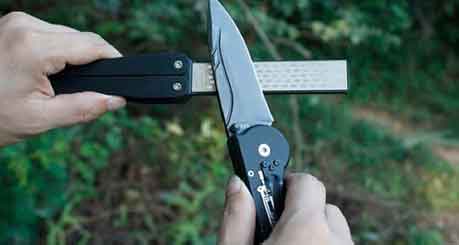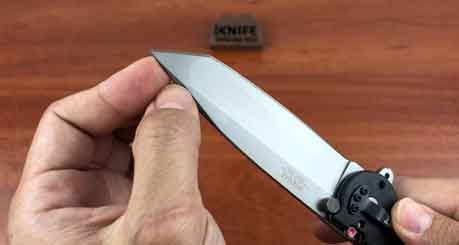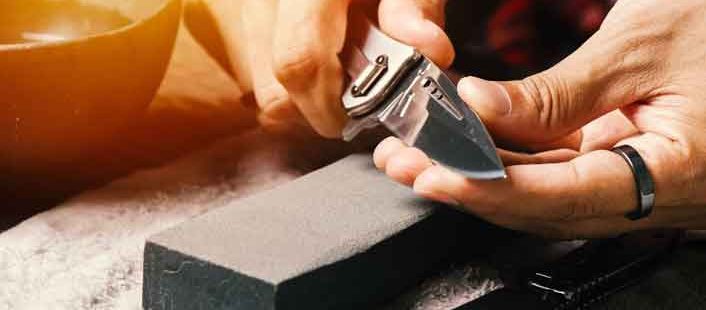You should sharpen your hunting knife whenever you see or feel a difference in the knife’ ability to cut. One way people test for sharpness is to run the pad of the thumb over the edge of the knife; this works but is dangerous. A better method is to try to cut a piece of paper, if the blade glides through the paper with out crumpling it the knife is sharp. So you have a frame of reference, try cutting a piece of paper with your new knife, before you cut anything else. When you sharpen your knife, this is what you are looking for, can you do better, sure, but only with practice.
Tools for Sharpening:

Knife sharpeners come in many shapes and sizes, some are made from natural materials others are synthetic. Some knife sharpeners are run off your house current, but I am not going to talk about these. The 3 main types of sharpeners are Arkansas Stone, Ceramic, Diamond, there are others but I will stop there.
Arkansas Stone:
If you ever watched your dad or grandfather sharpening a knife this is most likely what they used. As the name implies, this sharpener is made from a form of stone. Used for many generations, this is a relatively inexpensive sharpener, but is considered by many to be one of the best. The stone comes in grades and usually consists of 2 pieces of stone with differing amounts of roughness glued together.
Ceramic:

Offers a very high degree if durability and will last a lifetime. Great for finishing a knife, but is not the best choice for a really dull blade. Ceramic knife sharpeners usually consist of a wooden base and 2 ceramic sharpening rods. Some of the smaller “pocket” sharpeners use ceramic as the sharpening material, these are lightweight and easy to pack and make a great addition to your hunting equipment, https://www.emailmeform.com/builder/emf/sale/huusk-beoordelingen.
Diamond:
Offers the user speed and durability, diamond ships are embedded into the surface of the knife sharpener. The diamond sharpener is used in the same manner as the Arkansas stone sharpener. Although relatively new and a bit more money, the diamond knife sharpeners are gaining followers rapidly.
Lubricant:
With both the diamond and Arkansas Stone knife sharpeners you need lubricant, unless the manufacturer specified it as unnecessary in the directions that came with the sharpener. Honing oil or good quality general-purpose oil is used with the Arkansas Stone sharpeners. Water with a small amount of soap can be used with the diamond surface knife sharpeners. The lubricant is not used to help the knife glide; it is used to help remove the microscopic particles of steel that are left behind on the sharpener as the knife is sharpened.
How to Sharpen a Hunting Knife
The first step in sharpening a hunting knife is to determine the correct blade angle. This is easy to do, just look at the existing angle of the blade. You want to duplicate this angle. Once you have determined the correct angle and have lubricated the stone (if required) you place the stone on a solid surface and draw the knife across the sharpener. You should draw the knife in such a manner that it is cutting into the surface, not being dragged backwards. I prefer to draw the knife towards me, I have a few friends who go away from themselves, it is up to you. Maintaining the correct angle is critical, as is doing the same number of passes on each side, therefore keeping the edge even. If you find it difficult to maintain the correct angle, both DMT and Lansky offer sharpening systems that maintain the correct angle once set.
Once you have made a few passes on each side, clean the blade with a rag or moist sponge and test for sharpness. If you find the blade is sharp enough clean it up and oil it, if it is still dull continue sharpening until the desired degree of sharpness is acquired.
- How to Choose the Right Abrasive Tools and Supplies for Your Workshop? - September 28, 2024
- The Role of Sports Nutrition Supplement in Muscle Building - September 23, 2024
- The Evolution of Hydraulic CNC Press Brakes in China: From Traditional to High-Tech - September 4, 2024

